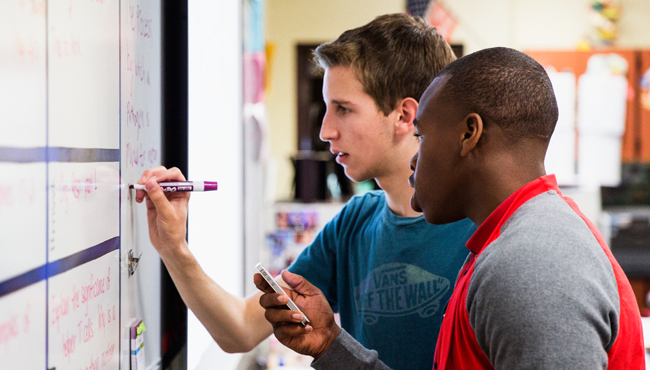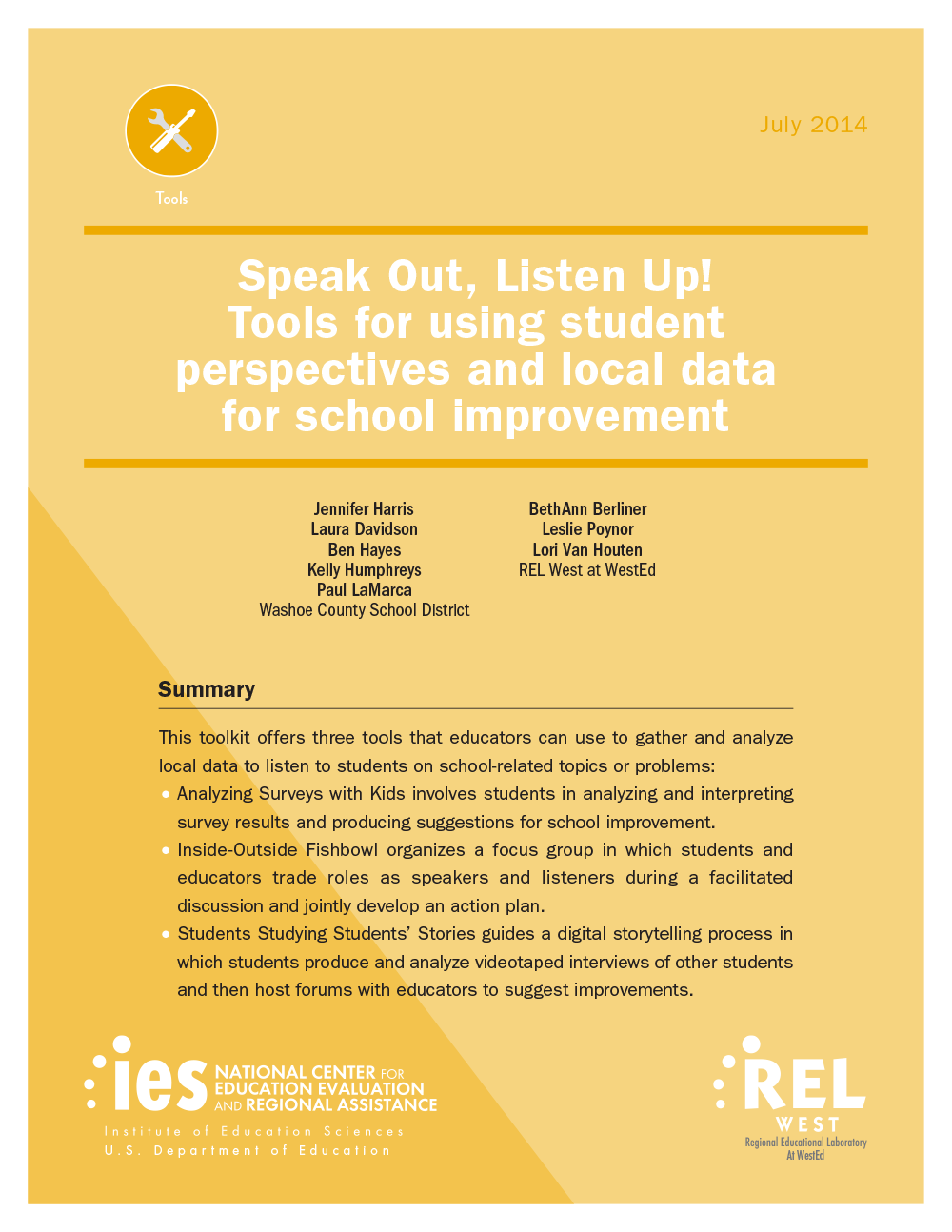When Students Speak and Educators Listen: Student-Voice Tools for Dropout Prevention
Posted on

Asked what she would tell adults trying to understand why students drop out of high school, Andrea* quietly responds: “Just because a student wants to drop out of school doesn’t mean she’s stupid or she’s lost hope.
“Listen to her. It might be the best thing you ever do.”
Like a disconcerting number of students across Nevada, Andrea, a teenager in Washoe County School District (WCSD), dropped out of high school. With only 71 percent of the state’s students graduating in the class of 2013, WCSD administrators have tried various strategies to reengage students like Andrea and keep them supported and on track to graduate. But they found that even when, through considerable effort, they could get students who had dropped out to return to school — attending district reengagement centers and receiving academic coaching — the same students often dropped out again.
So WCSD decided to tap into a rich source of data that had been missing from their previous efforts to reduce dropout rates: input from the students themselves.
“To support students in persisting and graduating, we knew we needed a deeper understanding of their reasons for quitting school,” says Jennifer Harris, a WCSD program evaluator. “And to do that, we needed to ask students to tell their personal stories of dropping out and returning to school, and really listen to what they had to say.”
Stress from mental health problems and bullying led Andrea to leave school, but she says that her determination to earn a high school diploma and pursue vocational training helped her decide to reenroll. She shares these insights in a powerful student-produced video in which she and seven other students who reenrolled in WCSD schools speak frankly about why they stopped attending school, the kind of support that would have helped them persevere, and why they came back. The video grew out of a partnership between WCSD and the Regional Educational Laboratory (REL) West at WestEd that focused on collaborating with WCSD students at risk of dropping out in order to better address their unique challenges.
This video has become a powerful tool for raising district- and state-level awareness of the challenges, strengths, and aspirations of individual students who dropped out of high school but later returned, giving themselves another chance to graduate — told in the students’ own words. The student-produced video has been shown to counselors and principals across WCSD, and Nevada’s state superintendent has requested that it be shown to school leaders in the state.
“I usually get calls from principals after it’s shown,” Harris says. “They ask me to show it to their whole staff.”
Finding the right tool for the job
Even though WCSD was committed to the notion of listening to student ideas about school improvement, “we had difficulty imagining what that would look like in our classrooms and schools across the district,” says Harris, who is part of a WCSD team that secured a five-year High School Graduation Initiative (HSGI) grant in 2011 from the U.S. Department of Education to build new pathways to graduation for students at risk of dropping out or for dropouts who return to school.
With momentum from their HSGI projects, in 2013 the WCSD team began to discuss additional practical strategies with BethAnn Berliner, a senior REL West researcher who works with a number of states and local education agencies in making data-based decisions to address dropout prevention and reengagement efforts. Those conversations led to the idea of developing a toolkit designed to elicit student perspectives and engagement — or student voice — to inform districtwide approaches to helping students persist and graduate.
While eliciting student perspectives to guide school improvement initiatives is not necessarily a new strategy, student experiences and ideas are usually “voiced” indirectly through responses to surveys or participation in meetings structured and led by adults, says Berliner. “It’s much less common for students to have authentic opportunities to partner with adults to wrestle with school problems,” she says, “and even rarer for students to plan and lead such efforts.”
Although the toolkit initially focused on dropout prevention, the final version developed and produced by WCSD and REL West, Speak Out, Listen Up! Tools for Using Student Perspectives and Local Data for School Improvement, is designed for use by all grade levels to address local school-improvement-related topics or problems. Berliner notes that students are seen as a key to finding solutions, rather than as a source of school problems. Research on the effectiveness of using student voice to address school change is just emerging, says Berliner, but the literature suggests that listening closely to what students say about their school experiences can help educators better understand and address local challenges and rethink policies and practices.
School climate research corroborates the connection between the use of student input to inform school improvement decisions and positive school outcomes. For example, a 2011 federally funded project to improve the climate of 58 California schools drew heavily on two strategies to incorporate student perspectives: using Student Listening Circles (like the Inside-Outside Fishbowl tool described later in this article) and having students analyze and discuss data from the California Healthy Kids Survey. A WestEd report on the project revealed that after two years, 86 percent of participating schools — which were selected based on their poor climate scores —improved their school climate. Furthermore, a large majority significantly improved their academic performance, as measured by students’ results on statewide standardized tests.
Empowering students to take action
Published by the U.S. Department of Education’s Institute of Education Sciences, the toolkit comprises three student voice tools, each of which has three essential components: collaboration between adults and students in a school setting, local data gathering and/or analysis on a school issue or problem, and an action step to address school improvement. The tools are:
- ASK (Analyzing Surveys with Kids): Students analyze and interpret existing local data (like survey results) associated with a school-related topic or problem, then produce explanations and suggestions for school improvement.
- Inside-Outside Fishbowl: Students and educators trade roles as speakers and listeners during a structured discussion of a school-related topic or problem, and jointly develop an action plan.
- S4 (Students Studying Students’ Stories): Students lead a digital storytelling process in which they produce and analyze videotaped interviews of other students discussing a school-related topic or problem, then host forums with educators to suggest improvements.
The tools vary in complexity, duration, and the amount of student responsibility. For instance, the S4 tool used to produce the WCSD video took a class of students at an alternative high school an entire semester to develop, with support from their teacher and a video editor. Those students — who had themselves dropped out of school and reenrolled — developed the interview questions, interviewed and videotaped the volunteer subjects, created a story line from the raw video footage, and participated in the editing. While they were still attending high school, they also introduced the video at showings for educator groups and participated in structured, reflective discussions afterward.
“The tools can help give disengaged students more responsibility and buy-in for school improvement efforts,” Berliner says, “and can help ensure that changes made to the school environment actually reflect student perspectives and needs.”
Gaining insights and challenging common perceptions
Many student comments in the video interviews confirmed that the reasons for dropping out are varied, complex, and personal. Some examples: mental health challenges not being addressed; special learning needs not being recognized or met; parents who have addiction and other problems; being bullied or in abusive relationships; or other life circumstances that interfere with staying on track to earn a diploma.
A common theme voiced across all the interviews was the fundamental need for a caring adult in the school setting who checks in with them regularly. “One of the reasons these students persisted was because they had caring teachers, coaches, and others in their lives who believed in them,” says Berliner.
Both Harris and Berliner have noticed that the students’ stories are challenging common preconceptions about who these students are as individuals. “They are smart and articulate, they take pride in being students, and they have high aspirations,” says Berliner. “And they want to be happy.”
Five of the eight students in the WCSD video graduated and are now working or in college. Two students are currently working toward a high school diploma, and one student dropped out again.
Using student voice to address a range of local challenges
Beyond offering a practical way to support dropout prevention, the Speak Out, Listen Up! toolkit has become a catalyst in WCSD for a different way of thinking about and acting on a range of school issues and problems. “New conversations are taking place in the district,” Harris says, “on topics like student mental health, the need for stronger wraparound supports for at-risk students, and improving school climate.”
WCSD has launched an interdisciplinary districtwide task force to better incorporate student voice in school improvement efforts. And the toolkit is being introduced to school teams across grade levels through the district’s Social and Emotional Learning Initiative. “Students are better able to realize and practice their social and emotional competencies when they can communicate their views on issues that are important to them,” Says Harris.
“I only fully realized how valuable the toolkit was when we started introducing it to other educators,” Harris says. “Now, when people ask us for support in using student voice to address school-improvement issues, we have solid strategies to offer them.”
For further information about the Speak Out, Listen Up! toolkit, contact BethAnn Berliner at 415.302.4209 or bberlin@WestEd.org.
For further information about using the toolkit, including developing and using a student-produced video, contact Jennifer Harris at 775.333.3766 or jharris@washoeschools.net.
*Andrea is a pseudonym used to protect this student’s privacy.

